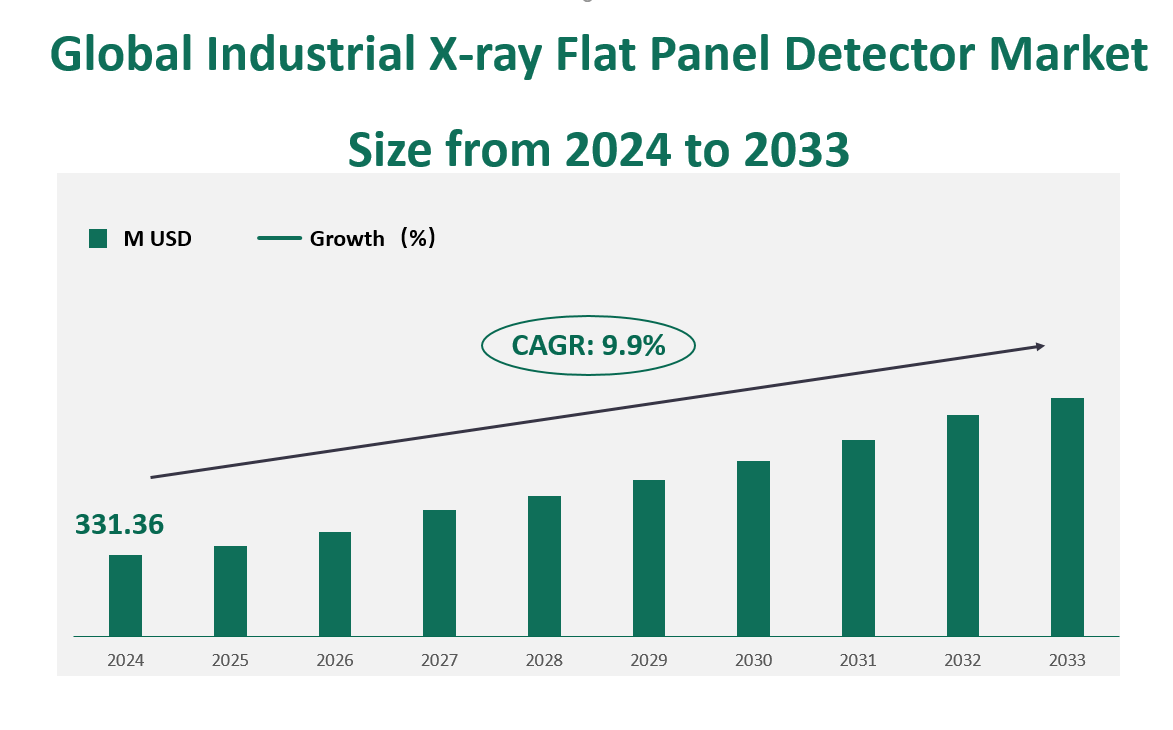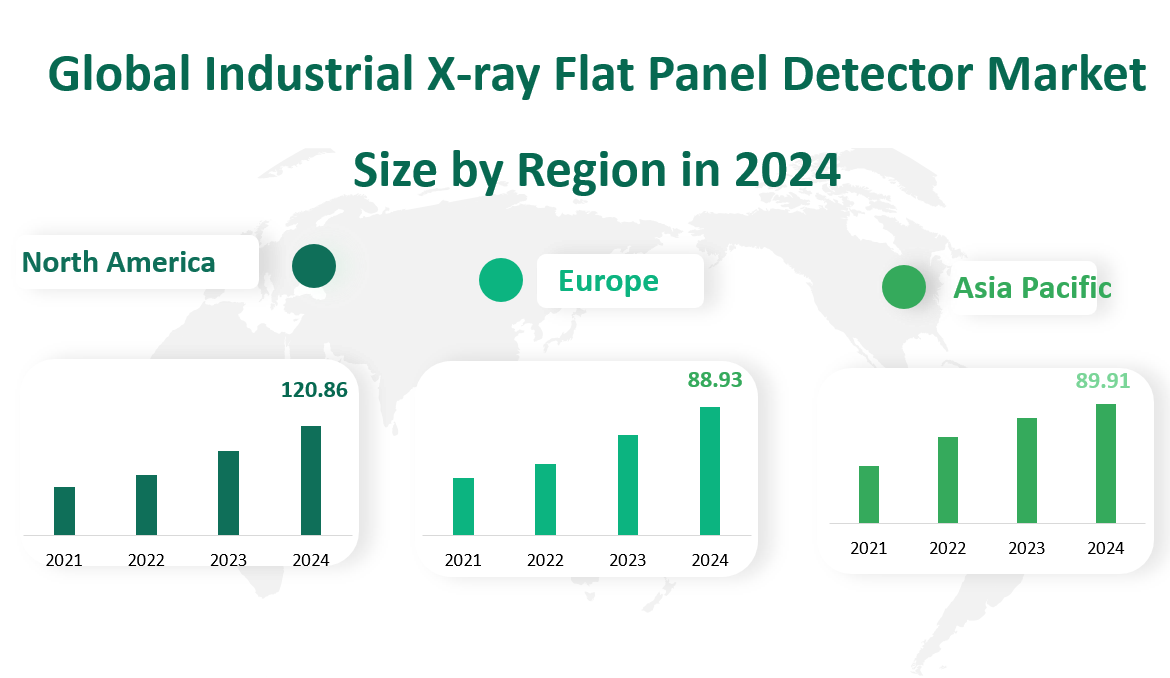1 Global Industrial X-ray Flat Panel Detector Market Size (Revenue) and CAGR (2024-2033)
The global Industrial X-ray Flat Panel Detector market has reached a total revenue of USD 331.36 million in 2024, with a CAGR of 9.9% from 2024 to 2033. This CAGR indicates that the industrial X-ray flat panel detector market is showing a strong growth trajectory in the future. This growth is attributed to the increasing demand for non-destructive testing (NDT) in various industries such as aerospace, automotive, oil and gas, and infrastructure.
An industrial X-ray flat panel detector is a digital solid-state X-ray radiographer that works on a principle similar to that of image sensors used in digital photography and videography. These detectors are used in projection radiography and can replace X-ray image intensifiers in fluoroscopy. Known for their speed and sensitivity compared to traditional X-ray films, flat panel X-ray detectors play a vital role in ensuring quality control and safety in industrial applications.
Figure Global Industrial X-ray Flat Panel Detector Market Size (M USD) Outlook (2024-2033)

2 Industrial X-ray Flat Panel Detector Industry Trends and Growth Drivers
Table Key Industry Trends of Industrial X-ray Flat Panel Detector
Item | Descriptions |
|
|
|
|
Table Technology Status and Developments in the Industrial X-ray Flat Panel Detector Market
Descriptions | |
|
|
|
|
3 Global Industrial X-ray Flat Panel Detector Revenue by Type in 2024
In 2024, the product types of industrial X-ray flat panel detectors are divided into direct conversion and indirect conversion. Direct conversion detectors do not require scintillators and directly convert X-rays into electrical signals. The direct conversion type of industrial X-ray flat panel detectors has a market value of $37.32 million in 2024. This type has gained a certain market group due to its superior performance in high-energy applications and its ability to provide clear images with less radiation. Although the direct conversion type of detectors has a smaller market share, the growth rate is high. This growth can be attributed to technological advances that have improved the performance of direct conversion detectors, making them more sensitive and faster than traditional methods. The absence of the need for a scintillator layer also increases their appeal in specific high-energy applications.
On the other hand, the indirect conversion type of industrial X-ray flat panel detectors has a revenue of $294.04 million in 2024. Indirect conversion detectors, which convert X-rays into visible light, dominate the market due to their improved image quality and cost-effectiveness. This dominance can be attributed to the widespread adoption of indirect conversion detectors in various industries due to their ability to provide high-resolution images and their ability to accommodate X-rays of different energy levels. Indirect conversion detectors are expected to have a considerable growth rate.
In conclusion, the industrial X-ray flat panel detector market is expected to achieve substantial growth, with technological innovations and strategic corporate activities playing a vital role in shaping the future of the market. Despite the challenges, the market expansion potential remains strong, especially against the backdrop of increasing quality control needs and technological advancements in non-destructive testing solutions.
Table Global Industrial X-ray Flat Panel Detector Revenue (M USD) by Type in 2024
| Revenue |
Direct Conversion | 37.32 |
Indirect Conversion | 294.04 |
Total | 331.36 |
4 Global Industrial X-ray Flat Panel Detector Revenue by Application in 2024
The automotive industry holds the largest market share with revenue of USD 91.47 million in 2024. This is attributed to the increasing demand for X-ray inspection for castings, welds, and material inspection, especially with the rise of electric vehicles. The Automotive Industry not only commands the largest market share but is also projected to have one of the fastest growth rates. This growth is driven by the rapid development of electric vehicles, which require advanced battery inspection technologies, and the overall advancement in automotive technology that demands high standards for material integrity.
The aerospace industry is expected to generate revenue of USD 49.6 million in 2024 and holds a significant share owing to stringent quality control requirements for aircraft components and safety regulations. The Aerospace sector, while not the fastest-growing, maintains a substantial share due to the high demand for reliable and precise X-ray inspection technologies for aircraft safety. The need for lightweight, strong materials in aircraft manufacturing has increased the reliance on X-ray Flat Panel Detectors for quality assurance.
The growth in these downstream industries can be attributed to several factors. The increasing complexity of products and the need for higher precision in manufacturing have led to a greater reliance on non-destructive testing technologies. Additionally, the push for quality control and safety regulations across industries has made X-ray inspection a necessity.
Table Global Industrial X-ray Flat Panel Detector Revenue (M USD) by Application in 2024
| Revenue |
Aerospace | 49.60 |
Automotive Industry | 91.47 |
Oil and Gas Industry | 73.54 |
Infrastructure Industry | 41.66 |
Power Generation Industry | 44.02 |
Others | 31.07 |
Total | 331.36 |
5 Global Industrial X-ray Flat Panel Detector Market Revenue by Region in 2024
The Industrial X-ray Flat Panel Detector market has been experiencing a surge in demand across the globe, with different regions showcasing unique growth trajectories. North America, with a revenue of USD 120.86 million in 2024, emerges as the largest regional market. This region’s dominance can be attributed to its strong industrial base, particularly in the automotive and aerospace sectors, which heavily rely on X-ray Flat Panel Detectors for quality control and safety checks. The region’s advanced healthcare infrastructure also contributes significantly to the market size, with a constant demand for advanced imaging technologies in medical diagnostics and research.
Europe follows closely with a revenue of USD 88.93 million in 2024. The region’s mature market is characterized by stringent safety regulations and a strong focus on quality control in manufacturing, which drives the demand for Industrial X-ray Flat Panel Detectors. Countries like Germany and the UK have well-established industrial sectors that utilize these detectors extensively, contributing to the region’s substantial market share.
The Asia Pacific region has a revenue of USD 89.91 million in 2024, making it a key player in the global market. The region’s rapid industrialization and the growth of manufacturing industries, especially in China and India, have led to an increased demand for X-ray Flat Panel Detectors. The region’s market is also driven by the need for advanced inspection technologies in the oil and gas, infrastructure, and power generation industries.
he revenue market share of the global Industrial X-ray Flat Panel Detector market in 2024 is mainly concentrated in Asia Pacific, Europe and North America. These three regions together account for the main share of the global Industrial X-ray Flat Panel Detector market, with Asia Pacific leading with a market share of 43.19%, Europe and North America ranking second and third with market shares of 29.15% and 21.68%, respectively.
The Asia Pacific region holds the largest share in the global Industrial X-ray Flat Panel Detector market, a position that is due to the region’s rapid industrialization and growing demand for efficient energy solutions. China, as the main economy in the region, has driven a large demand for Industrial X-ray Flat Panel Detectors with its leading position in manufacturing, especially in the automotive, electronics and chemical industries. In addition, technological advancement and the pursuit of sustainable energy solutions in the Asia Pacific region have also provided impetus for the development of the Industrial X-ray Flat Panel Detector industry. The European region is known for its strong industrial base and strict compliance with environmental regulations, which has driven the demand for high-quality and energy-efficient Industrial X-ray Flat Panel Detectors. North America, especially the United States, has a growing demand for high-performance Industrial X-ray Flat Panel Detectors with its leading position in innovation and technology, especially in the aerospace and high-end manufacturing sectors.
Figure Global Industrial X-ray Flat Panel Detector Market Revenue (M USD) by Region in 2024

6 Global Industrial X-ray Flat Panel Detector Revenue Market Share by Major Players in 2023
The Industrial X-ray Flat Panel Detectors market is highly competitive and key players such as Carestream Health, Varex Imaging, Fujifilm, and Iray Technology are contributing significantly to the industry growth.
In 2023, Carestream Health achieved a sales revenue of USD 67.97 million, reflecting a strong market position and the continued demand for its advanced imaging solutions. Carestream Health, established in 2007 and headquartered in the USA, is a global provider of medical imaging systems and X-ray imaging systems for non-destructive testing (NDT). The company operates on a worldwide scale, offering a broad range of imaging solutions backed by a robust service and support network. Carestream Health is known for its INDUSTREX HPX-DR 2530 PC High-Speed Detector, designed for high-speed NDT imaging. This compact and durable detector boasts a 145 μm resolution and requires a lower exposure dose for faster throughput, accelerating the analysis and reporting process.
Varex Imaging recorded a sales revenue of USD 51.13 million in 2023, demonstrating the company’s significant impact on the market with its innovative products and solutions. Varex Imaging, founded in the 1930s and based in the USA, is a leading independent supplier of medical X-ray tubes and image processing solutions. The company’s components are utilized by X-ray imaging system manufacturers globally for various applications, including medical imaging, cargo screening, and border security. Varex Imaging’s product line includes the XRpad2 3025i, featuring a 100 µm pixel size and direct deposition CsI or Gadox scintillator. This detector enables high-resolution imaging with reduced X-ray exposure time and is designed for easy system integration and field usage.
Table Global Industrial X-ray Flat Panel Detector Revenue (M USD) by Major Players in 2023
Company | Revenue |
67.97 | |
51.13 | |
45.04 | |
46.39 |





